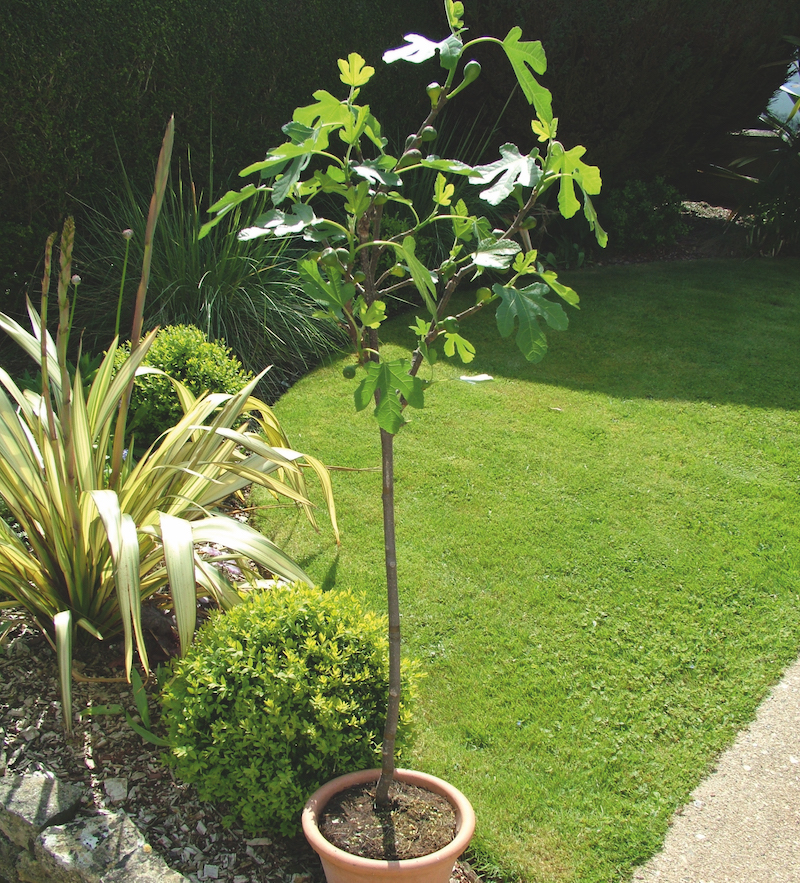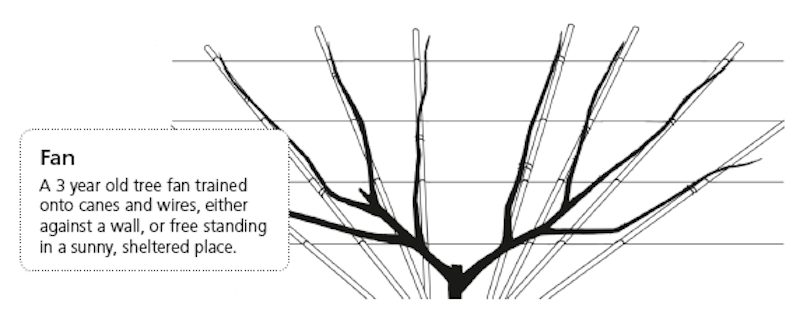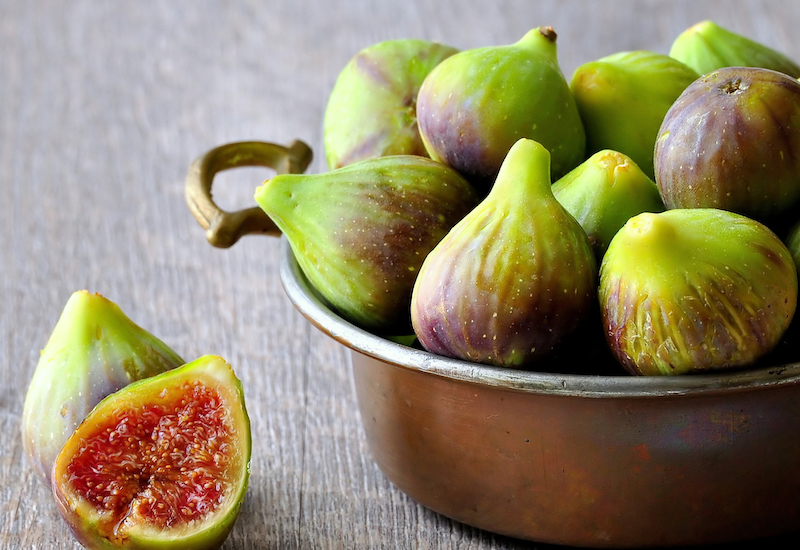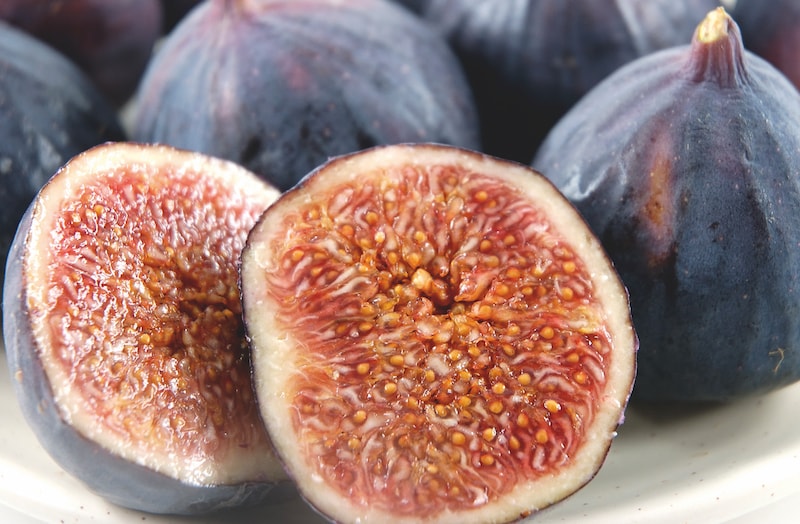If you’ve ever dreamed of successfully growing your own fig tree, here’s how to do it. Even if you don’t have a huge garden, figs will happily grow in a large container on a sunny patio. Simply follow these instructions and look forward to owning a beautiful tree which produces copious quantities of delicious, sweet, juicy fruit.
About fig trees
The fig is a small, attractive tree native to the Mediterranean and Western parts of Asia. It has smooth pale bark and distinctive leaves featuring three to five lobes. The tree produces deliciously sweet teardrop-shaped fruits which are green on the outside, ripening to a purple-brown colour. Inside they contain reddish flesh with many crunchy seeds.
It’s not only the fruits that are edible; the leaves can also be used to make tea, impart flavour to curries, wrap cheese or infuse syrup.
How to plant a fig tree in the UK

Image: Gartland/Shutterstock
There are two main options for growing fig trees here in the UK. Either plant your tree in a freestanding pot using soil-based potting compost, or train it as a fan against a sunny south-facing wall. If planting into the ground, you’ll also need a way to control the roots which otherwise grow very vigorously, reducing the tree’s tendency to set fruit.
To restrict your fig’s roots, plant it in a 37.5cm (15”) pot and, if planting against a wall, bury it until the soil is level with the rim and the rim is touching the wall. Alternatively, construct a fig pit. To do this, dig out a hole of approximately 60 cubic centimetres (24 cubic inches) and line the sides with bricks or paving slabs. In the bottom place a 23cm (9″) layer of tightly packed broken bricks or rubble. Refill with soil adding well rotted manure or garden compost and a little bonemeal. If you’re growing your fig in a pit next to a wall, plant it 23cm (9″) away from the base of the wall. Whether you plant in a pot or in a fig pit, make sure you tamp the roots down firmly.
Growing a standard fig tree

Image: Fig Brown Turkey from Suttons
A standard fig is one which you train to have a clearly defined trunk with a symmetrical crown of branches. In most respects standards can be grown as for a bush fig which we discuss below. Because of their trained shape, standards are best suited for growing in a large pot or tub which also has the benefit of restricting root growth and limiting vigour. If you do decide to grow your fig in a pot, make sure you feed and water it very regularly, especially in the spring and summer months when the weather is drier and growth is rapid.
The head of the fig tree should be built up steadily to achieve and maintain the classic standard form. To this end, side branching can be encouraged by reducing the soft growing branches by up to one third. Mid-summer is the ideal time to do this.
Training and pruning your fig tree
To train your fig as a fan against a wall, treat it in the same way as apricots, peaches and nectarines. In February, cut about one third off both side shoots, pruning back to a bud. Allow four shoots to develop on each and train to an even fan shape, spacing at least 30cm (12″) apart.

How to train a bush fig

Image: Fig (Ficus) Brunswick (bush) 3L pot from Suttons
To train a freestanding pot-grown fig bush, prune in winter cutting back to just above a bud approximately 65–75cm (26–30″) from the soil surface. The following winter, select four or five shoots to form the framework and cut back by a third. Remove all the other laterals. The following year, cut these chosen shoots back by half, also removing any branches crossing the centre of the bush. Any shoots not required for the framework are cut back to four buds. Repot every second year to a pot size of 30–37cm (12–15″) while dormant in early spring. Loosen soil around the root and cut away any strong thong like roots to encourage a fibrous root system.
Pruning an established fig tree
Prune established fig trees in June, pinching back all young shoots to 4 or 5 leaves to encourage fruiting shoots to form. In the spring, tidy up both fan and bush trained plants by removing shoots killed by frost. Thinning may be necessary by removing some of the old wood. On fan-trained plants, remove buds which are pointing directly inwards or away from the wall.
Seasonal fig tree care

Image: Fig Little Miss Figgy from Suttons
Because you’ve restricted your fig’s ability to put out roots, it’s vital to water it regularly. Dry soil conditions will result in the fruit dropping. You may also need to protect fruit from birds, particularly as it ripens. Each spring, apply a light dressing of a general fertiliser like Growmore and mulch with well-rotted garden compost. Apply a high potash liquid fertiliser at 2–3 week intervals. Once fruit starts to swell, feed free-standing, pot grown plants at 10 day intervals with a high potash liquid feed of the type used for tomatoes.
Fig trees are capable of producing two or three crops a year but in the cool UK climate only one will ripen. In September, remove any cherry-sized fruit from the tree as this won’t ripen, but do leave smaller pea-sized fruit found near the ends of the shoots as these will develop into next season’s crop.
Because fruits form during the previous season, frost protection is a must. Protect fan-trained plants with fleece from autumn to spring. Pot-grown plants can be moved into a cold greenhouse, shed or garage or covered with fleece on cold frosty nights.
Figs ripen in August and September. The fruit is ready for picking when it has turned a brownish-red and hangs down – the skin may be cracked or there may be a drop of nectar at the base.
Now you know how to grow, train and care for a fig tree in the UK, all that remains is to pick your favourites from our wonderful selection of fig and fruit trees.
Lead image: Fig (Ficus) Moerheim from Suttons
Last Updated on November 8, 2024 by Suttons Horticultural Team






Are you sure about a fig pit hole 60 cubic centimetres? That’s approx 4cms x 4cms x 4cms. That can’t possibly be right.